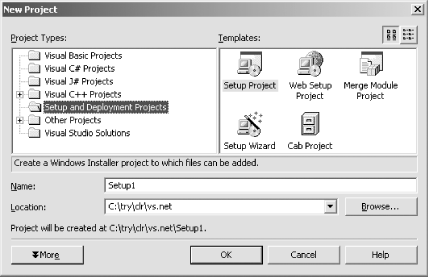6.2 Setup Project Types
A Setup project should be in the same
Visual Studio .NET solution as the project whose output it will be
installing. New Setup projects are added to a solution in the same
way as any other project. (Either use File  Add
Project Add
Project  New Project... or use the solution
item's context menu in the Solution Explorer,
choosing Add New Project... or use the solution
item's context menu in the Solution Explorer,
choosing Add  New Project....) There are several
different project types in the Add New Project
dialog's Setup and Deployment Projects category, as
Figure 6-2 shows. New Project....) There are several
different project types in the Add New Project
dialog's Setup and Deployment Projects category, as
Figure 6-2 shows.

 |
When you add a new Setup project, the project will not be added to
any of your configurations by default. This is because Setup projects
take a while to build—since the output of a Setup project is
usually needed only toward the end of the development cycle, it would
be a waste of time to wait for an .msi file to
be built every time.
You can get Visual Studio .NET to build your project either by adding
it to one of your configurations or by selecting Build from the
project's context menu in the Solution Explorer.
|
|
All Setup projects work in much the same way. The main differences
are related to the way in which the component will actually be
deployed. The role of each project type is shown in Table 6-1.
Table 6-1. Setup project roles
|
Setup Project
|
For applications that will be installed on the end
user's computer.
|
|
Web Setup Project
|
For applications that will be installed on or deployed through a web
server.
|
|
Merge Module Project
|
For components that will be used by other applications. (Merge
modules can be imported into either normal applications or web
applications.)
|
|
Cab Project
|
For legacy component installation through a web browser. (Typically
used for ActiveX controls.)
|
|
Setup Wizard
|
To create one of the four other project types, according to the
selection made in the wizard.
|
 |
Although it is usually fairly obvious which kind of Setup project you
require, there is one exception. If you were writing a .NET Windows
Forms application, you would expect to create a normal Setup project,
since the application runs on the end user's
computer. And usually you would be right. However, .NET allows such
applications to be deployed via a web server. In this case, although
the code ultimately ends up running on end users'
machines, the installation step is done on the web server. So if you
plan to deploy your Windows Forms applications via a web server, you
need a Web Setup project.
|
|
Cab projects are provided only for support of legacy scenarios. Cab
files do not use Windows Installer, so there is a great deal less
flexibility about how the target machine will be configured. You
should use one of the other project types unless backward
compatibility requirements force you to use a Cab file. Cab projects
are discussed in more detail toward the end of the chapter.
|
